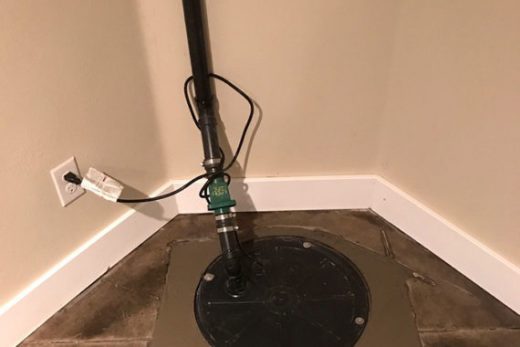Helpful Tips for Maintaining a Sump Pump
Helpful Tips for Maintaining a Sump Pump
Blog Article
Just about everyone is bound to have their own idea involving How To Effectively Clean A Sump Pump.

Sump pumps are crucial components in several homes, especially in locations prone to flooding or excessive dampness. They help avoid water damages by efficiently eliminating excess water from basements or crawl spaces. Nonetheless, like any other appliance, sump pumps need regular maintenance to guarantee they work successfully when required one of the most. Cleaning your sump pump is an important part of its maintenance, and comprehending just how to do it properly can save you from pricey repairs and prospective catastrophes.
Introduction
Preserving a clean sump pump is crucial for its appropriate functioning and durability. Ignoring this essential job can bring about obstructions, malfunctions, and ultimately, water damages to your residential property. Therefore, learning exactly how to clean a sump pump is essential for homeowners who depend on these gadgets to maintain their basements dry and secured.
Signs of a Dirty Sump Pump
Understanding when your sump pump requires cleaning is essential for protecting against potential breakdowns. Some common indications that suggest a filthy sump pump include unusual sounds throughout operation, minimized water circulation, and noticeable debris in the pit. If you discover any one of these signs and symptoms, it's vital to clean your sump pump immediately to stay clear of any kind of additional issues.
Getting ready for Cleaning
Before you begin cleansing your sump pump, it's important to take some safety and security precautions. Beginning by turning off the power to the pump to prevent any electrical crashes. In addition, wear suitable safety gear, such as handwear covers and safety glasses, to safeguard yourself from dirt, debris, and prospective microorganisms.
Recognizing the Sump Pump
Prior to diving into the cleaning procedure, it's essential to have a basic understanding of how a sump pump works. Usually mounted in a pit or basin listed below the basement flooring, a sump pump includes numerous vital parts, including a pump, a float button, and a discharge pipe. When water collects in the pit, the float switch turns on the pump, which after that pumps the water out with the discharge pipeline, away from the structure's foundation.
Step-by-step Overview to Cleaning a Sump Pump
Turning off the Power
Begin by disconnecting the power supply to the sump pump to avoid any kind of accidents while cleansing.
Checking for Proper Performance
Prior to reinstalling the pump, do a fast examination to guarantee that the float switch triggers the pump appropriately. Put some water right into the sump pit and observe the pump's procedure. If everything is functioning correctly, you can reassemble the pump and reconnect the power supply.
Eliminating Debris and Dust
Make use of a pail or an inside story to eliminate any type of noticeable particles, dirt, or debris from the sump pit. Dispose of the debris correctly to prevent it from obstructing the pump or the discharge pipeline.
Cleaning the Pump and Float Switch
As soon as the pit is clear of debris, very carefully remove the pump from the pit. Evaluate the pump and the float switch for any kind of signs of damage or wear. Use a soft brush or fabric to clean up the surfaces and get rid of any type of gathered gunk.
Purging the System
After cleansing the pump and float switch, flush the sump pit with tidy water to remove any type of continuing to be dust or debris. This will certainly aid make sure that the pump operates efficiently and efficiently.
Upkeep Tips to Maintain Your Sump Pump Clean
In addition to regular cleaning, there are a number of maintenance ideas you can follow to maintain your sump pump in optimal condition:
Conclusion
Cleaning your sump pump is a crucial aspect of its upkeep and ensures that it operates effectively when you require it one of the most. By adhering to the steps described in this guide and integrating routine upkeep into your regimen, you can extend the lifespan of your sump pump and protect your home from water damage.
6 STEPS ON HOW TO CLEAN A SUMP PUMP PROPERLY
UNDERSTANDING SUMP PUMPS
Your sump pump plays a crucial role in protecting your home by managing and removing excess water. It primarily functions as a “shield”, guarding your basement against the damaging effects of water accumulation. The pump is housed in a sump pit in the lowest part of your basement, and its job is to pump out any water that collects there.
During heavy rainfalls or when snow melts rapidly, water can infiltrate your basement, posing potential risks like flooding, structural damage, and harmful mold growth. Here, the sump pump springs into action, pumping out the intruding water and directing it away from your home.
SAFETY FIRST
Before cleaning, remember to prioritize safety. Disconnect the sump pump from the power source to prevent any accidental electric shocks. Also, wear sturdy gloves to protect your hands from any sharp or dirty components within the pump.
REMOVE THE SUMP PUMP
After ensuring your safety, the next step is to remove the sump pump from its pit. Doing this might require careful maneuvering as you don’t want to damage any pump components. Once removed, clean the sump pit to remove any accumulated debris or sludge.
INSPECT THE PUMP
Inspect the pump for any visible signs of wear or damage. Check the power cord, float switch, and impeller housing. If any components look worn out or damaged, consider replacing them to ensure optimal performance.
CLEAN THE PUMP
Thoroughly clean the pump with warm, soapy water. Make sure to rid it of any dirt, gravel, or other debris that might impede its performance. You can use a toothbrush to clean the small, hard-to-reach parts of the pump.
REINSTALL THE SUMP PUMP
Reinstall the pump into the sump pit Make sure it’s positioned correctly to remove the water effectively Once it’s back in place, reconnect it to the power source TEST THE PUMP
Finally, pour some water into the pit to ensure the pump works correctly. It should start automatically and begin pumping out the water; if it doesn’t, check the power source and the positioning of the pump.
Remember, while cleaning your sump pump is an essential part of home maintenance, hiring a professional plumber for a thorough inspection and cleaning at least once a year is also important. This will ensure that your pump is in optimal condition, ready to protect your home from potential water damage.
BEST PRACTICES FOR CLEANING SUMP PUMP DISCHARGE PIPES
Regular Inspection: Regularly inspect your discharge pipes, especially during heavy rainfall or snowmelt periods. Look for any signs of blockage or damage. Early detection of problems can prevent serious issues down the line. Periodic Cleaning: Over time, sediment and debris can accumulate in the discharge pipes, impeding the flow of water. Regular cleaning helps keep the pipes clear and functioning efficiently. You can use a high-pressure water jet to effectively clean the pipes. Insulation During Winter: In colder climates, discharge pipes can freeze, blocking the outflow of water. Protect your discharge pipes from freezing temperatures by insulating them with foam pipe insulation. This will ensure the sump pump can continue to discharge water even in freezing conditions. Proper Positioning: The discharge pipe should be positioned to direct water away from your home’s foundation. Improper positioning can lead to water seeping back into the basement. Ensure the pipe is long enough and angled correctly. Installation of a Check Valve: A check valve prevents water from flowing back into your sump pit after the pump has pushed it out. Installing a check valve helps maintain the efficiency of your sump pump and reduces the risk of flooding. Minimize Pipe Turns: Every curve or turn in the discharge pipe can decrease the efficiency of water flow. By minimizing turns and bends in your discharge pipe, you can increase the efficiency of your sump pump. https://www.fullspeedplumbing.com/how-to-clean-a-sump-pump-properly9999/

I'm very intrigued by Cleaning & Maintenance Tips for Your Home's Sump Pump and I am praying you enjoyed reading the entire entry. Enjoyed reading our article? Please quickly share it. Let other people discover it. Kudos for being here. Come back soon.
Call Today Report this page